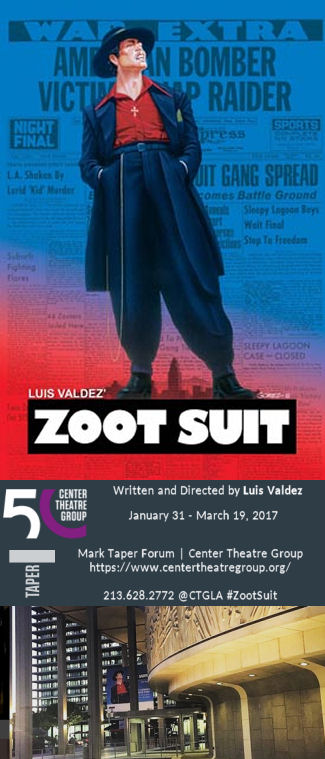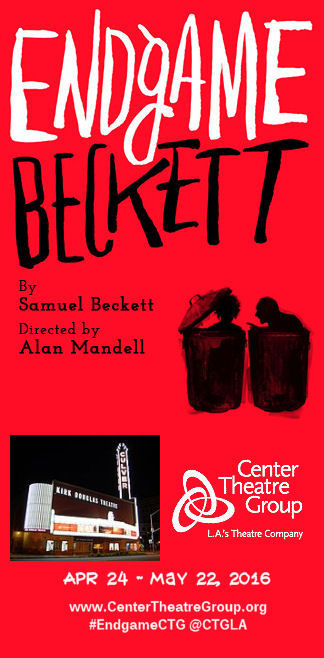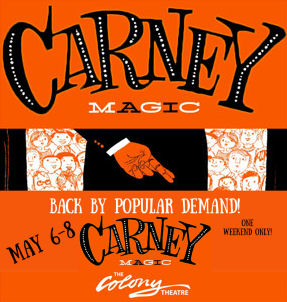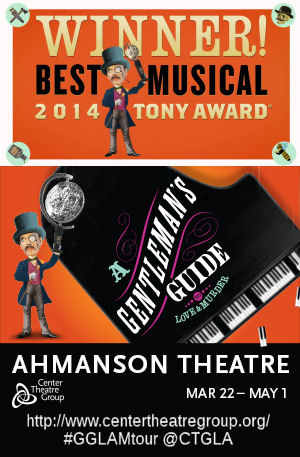
 Sometimes, you see a show and wonder what was going through the instigator’s mind. What prompted Stephen Sondheim to see a musical in the story of Sweeney Todd? What led Kander and Ebb to see a musical in the story of the Scottsboro Boys? Why did Merrill and Styne see a musical in the story of Prettybelle? Why, oh why, was there a notion to musicalize “The Madwoman of Chaillot” as Dear World? Musicalize Carrie? What are you smoking?
Sometimes, you see a show and wonder what was going through the instigator’s mind. What prompted Stephen Sondheim to see a musical in the story of Sweeney Todd? What led Kander and Ebb to see a musical in the story of the Scottsboro Boys? Why did Merrill and Styne see a musical in the story of Prettybelle? Why, oh why, was there a notion to musicalize “The Madwoman of Chaillot” as Dear World? Musicalize Carrie? What are you smoking?
Then, surprisingly, the ideas sometimes work out. Sweeney Todd is a masterpiece. History is showing that there was more to Carrie – The Musical than originally seen. Scottsboro Boys may eventually find its place as well.
There’s no hope, however, for Dear World or Prettybelle.
Then there is last night’s show at the Ahmanson Theatre (FB): Grey Gardens, the Musical. One wonders what possessed book writer Doug Wright, composer Scott Frankel, and lyricist Michael Korie, to see a musical in the documentary film “Grey Gardens” by David and Albert Maysles, Ellen Hovde and Muffie Meyer, and Susan Froemke, is beyond me. The result — which tells of the dysfunctional mother-daughter relationship of Edith Ewing Bouvier Beale and her daughter Edith Bouvier Beal (“Little Evie”) — may have great performances, but the story leaves you shaking your head and asking “Why?”
Let me elaborate. The title, Grey Gardens, refers to an estate in East Hampton, NY, that was purchased in the mid-1920s by the Phelan Beale. Beale was a Wall Street banker, and his with, Edith, was socialite and singer, whose primary claim to fame was as the aunt of Jackie Kennedy Onassis. Jackie, and her sister Lee, used to spend their summers with their aunt during the 1940s at Grey Gardens. Edith and Phelan’s daughter, also named Edith, was another aspiring actress. Any chance she had for marriage with thwarted by her mother, and eventually both Ediths ended up living in squalor in Grey Gardens with a collection of over 50 cats and feral raccoons. The situation was so bad they were threatened by the East Hampton health department. A documentary film was made of their story, and it became a cult classic.
The musical, Grey Gardens, attempts to tell the story in the documentary. The first half occurs in the 1940s, and centers on the engagement party for Little Edie and Joseph Kennedy Jr. (Jack Kennedy’s older brother). Big Edie sabotages the engagement to bring attention to herself, and Little Edie storms off to New York. This act takes some liberties with the story: there is no confirmation of the Kennedy-Beale engagement or this party; the actual party was a coming out party for Edie’s brother and took place earlier, with the divorce telegram actually arriving in 1946. The second half occurs in the early 1970s, and is essentially the documentary brought to life. It shows what Big and Little Evie’s life had degenerated into, their self-delusions, their dysfunctional relationship.
Ultimately, however, the show is a picture of a dysfunctional mother, and how she screwed up her daughter. Why we would want to see this — when there is no ultimate redemption — is beyond me. So you’re probably asking why I bought tickets? That’s easier to answer: I had seen the performance on the Tonys (they did the opening number from Act II), and had heard the music, and wanted to see how they handled the story. My conclusion was that there were some very good numbers, some excellent performances, but the story was one of those train wrecks that make you wonder afterwords why you found it so interesting.
My wife identified the problem well: both she and I grew up with mothers who were easily like this. We escaped. So why would we want to see a story that shows what could have been? It didn’t leave us with a great feeling.
That’s not to say there were not redeeming aspects. This wasn’t a complete train wreck like I Caligula, The Musical. A number of the songs are very entertaining, such as “The Five-Fifteen” (a dangerous ear worm), “Marry Well”, “The Revolutionary Costume for Today” (the number I saw on the Tonys) and “The House We Live In”. But I think the most poignant number is the penultimate one, “Another Winter in a Summer Town”, which could easily be a sad standard. It captures well the sadness of Little Evie’s life, what happens in the Winter for a Summer Town girl.
The performances were much stronger than the story itself. The trick conceit of this show is that the actress playing “Big Evie” in the first act becomes the Little Evie of the second act. This Edith was portrayed by Rachel York, who gave a remarkable performance. According to two of the orchestra members we spoke to after the show at the Metro station, her performance perfectly captured the Little Edie of the documentary. I haven’t seen the documentary, but it was a strong performance both in characterization and vocalization. She was just mesmerizing on stage.
Playing against York’s Little Edie in the second act, as Big Edie, was Betty Buckley (FB). Again, this was a great performance of a controlling woman, who achieved the control in various passive aggressive ways. Another example of strong characterization and vocalization. The two played well against each other — you could believe they were mother and daughter fighting.
At this point, I’ll interject to credit the director, Michael Wilson. I can never tell what comes from the director and what comes from the actor, but Wilson clearly worked with this cast to make the portrayals realistic, and it worked.
Playing against York’s Big Edie in the first act was Sarah Hunt (FB). I quite enjoyed Hunt’s performance — I thought she captured the spunk and the scheming of Little Edie quite well, and was extremely cute in “Two Peas in a Pod”.
Before I go to the other adult characters, I want to mention two who stole the show whenever they were onstage: Katie Silverman (FB) as Jacqueline Bouvier and Payton Ella (FB) as Lee Bouvier. These two little girls were cute as proverbial buttons, strong singers and dancers, and just fun to watch. Did I mention they were cute as buttons?
Turning to the main male characters. Simon Jones was very strong as J. V. “Major” Bouvier and Norman Vincent Peale — I particularly enjoyed him in “Marry Well”. The book doesn’t quite capture what he did in real life, but the performance was a hoot none-the-less. Josh Young (FB) demonstrated his strong singing and performance skills as both Joseph P. Kennedy Jr and Jerry, especially in “Going Places”.
Rounding out the male performers in named roles were Bryan Batt (FB) as George “Gould” Strong and Davon Williams (FB) as Brooks Sr. and Brooks Jr. Both were very strong; Batt was wonderful in his facial expressions and playfulness. I also noticed he was actually playing the piano.
Rounding out the cast as the ensemble players — choir members in some scenes, the camera and sound operators, asst. townspeople — were…. well, the ensemble isn’t explicitly credited as ensemble. Understudies are credited, so I’ll presume that the ensemble consisted of some subset of the understudies. The “understudies” were: Olivia Curry (u/s Jackie Bouvier, u/s Lee Bouvier), Rogelio Douglas Jr (FB) (u/s Brooks Jr, u/s Brooks Sr.), Steven Good (FB) (u/s George “Gould” Strong, u/s Kennedy Jr/Jerry, u/s Major Bouvier), Melina Kalomas (FB) (u/s Little Evie), Michelle London (FB) (u/s Young “Little” Evie, Dance Captain), and Rebecca Spencer (FB) (u/s Edith Bouvier Beale).
This was not your typical show, with large dance numbers with long-legged chorines. There was some dance, and there was definitely movement, and it was under the choreography of Hope Clarke. Still, some numbers exhibited great movement — in particular, “Marry Well”, “Two Peas in a Pod”, and “The House We Live In”. Charles Swan (FB) served as Associate Director/Choreographer.
The music was under the music direction of Kevin Stites, who served as the conductor and lead keyboard for the hidden orchestra. The other orchestra members were: Gerald Sternbach (FB) (Associate Conductor, Keyboard); Sal Lozano (Reed 1); Jeff Driskill (Reed 2); Laura Brenes (French Horn); John Fumo (FB) (Trumpet); Jen Choi Fischer (Violin); David Mergin (Cello); Ken Wild (Bass); and Cliff Hulling (Percussion). Robert Payne was the Music Contractor.
Turning to the other creative aspects: The scenic design was by Jeff Cowie; the lighting design was by Howell Binkley; and the projection design was by Jason H. Thompson (FB). I mention these three in one breath because they all integrated together. The scenic design was a combination of a decayed shingle house (which reflected the pictures I’ve seen of the real Grey Gardens), but built upon projections to establish the time of day and to provide background for various songs. More significantly, the projections included documentary style film output that was seemingly real-time, yet I couldn’t always find the camera. All three integrated with the lighting to focus attention and provide mood impacts. The sound design of Jon Weston was clear and didn’t overpower, although at times you could tell you were listening to the speaker instead of the person speaking. The costume design of Ilona Somogyi combined with Paul Huntly‘s wig design to bring the characters to life. I particularly noted how the costuming reflected the real quirky sensibilities of the real Little Evie, as well as the style of the clothes that the little girls wore. Rounding out the production credits: Original Casting – Stewart/Whitley (FB); L.A. Casting – Beth Lipari, CSA (FB); Production Stage Management – Robert Bennett; Assistant Stage Manager – Denise Yaney. This production was “inspired” by the Bay Street Theatre production with the same leads and the same director (and, not surprisingly, many of the same costumes).
Grey Gardens continues at the Ahmanson Theatre (FB) through August 14th. Tickets are available through the Ahmanson Box Office. Discount tickets may be available through Goldstar, and $25 HotTix may be available by calling the Ahmanson at 213.628.2772. Should you go see it? If you liked the documentary, or want to see an odd musical about a dysfunctional mother/daughter relationship, go. If that’s not your bag, or you want a traditional musical, skip it.
Regarding the HotTix comment. As we walked into the show, the subscription sales pushing critter stated that HotTix will not be available next season. I haven’t been able to confirm that online; I have a question into to CTG Customer Service. Looking at their subscription packages raises a number of question, especially as they have gone to a seating plan that divides up the orchestra (which could be the rationale for eliminating HotTix). This is a plan similar to the Pantages, and it is what drove us to subscriptions. However, their pricing makes no sense: (a) they do not offer subscription seats in either the Premium or the back Mezzanine or Balcony (which both contradicts their claim of subscriptions getting the best seats, as well as providing affordable subscriptions in the back as they used to do); (b) their pricing for the full subscriptions (6 shows) tends to have higher prices than the design-your-package with a minimum of 4 shows (the “design your package”, for Saturday Night, has $23 for D, $38 for C, $65 for B, and $90 for D, whereas the full subscription is $33, $48, $75, and no option for A; and (c) the “Passport” has only a single price, making its use for the lower price tickets non-sensical (they should offer a tier of Passports that tie to the seating areas, with discounts in other areas). Again, I have a query into CTG Customer Service.
* * *
Ob. Disclaimer: I am not a trained theatre critic; I am, however, a regular theatre audience member. I’ve been attending live theatre and concerts in Los Angeles since 1972; I’ve been writing up my thoughts on theatre (and the shows I see) since 2004. I do not have theatre training (I’m a computer security specialist), but have learned a lot about theatre over my many years of attending theatre and talking to talented professionals. I pay for all my tickets unless otherwise noted. I am not compensated by anyone for doing these writeups in any way, shape, or form. I currently subscribe at Cabrillo Music Theatre (FB), the Hollywood Pantages (FB), Actors Co-op (FB), and I plan to renew my mini-subscription at the Valley Performing Arts Center (VPAC) (FB). Past subscriptions have included The Colony Theatre (FB) (which went dormant in 2016), and Repertory East Playhouse (“REP”) (FB) in Newhall (which entered radio silence in 2016). Through my theatre attendance I have made friends with cast, crew, and producers, but I do strive to not let those relationships color my writing (with one exception: when writing up children’s production, I focus on the positive — one gains nothing except bad karma by raking a child over the coals). I believe in telling you about the shows I see to help you form your opinion; it is up to you to determine the weight you give my writeups.
Upcoming Shows: July brings us back to conventional theatre and performance. Next weekend brings a Fringe encore performance of Thirteen’s Spring, as well as The Little Mermaid at Cabrillo Music Theatre (FB). The end of July gets busy, with Weird Al Yankovic at the Hollywood Bowl (FB) on July 23, Operaworks (FB) Opera Re-Constructed at CSUN on July 24 (pending ticketing), and a mid-week Hollywood Bowl (FB) concert of Wynton Marsalis and Aaron Copeland on July 28, and … currently nothing for the weekend. August is a bit more open in terms of theatre. The first weekend just has a Jethawks game on Sunday; the second weekend has a hold for a Bar Mitzvah. The third weekend brings another event from the wonderful counter-cultural orchestra, Muse/ique (FB) — American/Rhapsody — a celebration of George Gershwin. Late August sees us looking at shows down San Diego/Escondido for one weekend. The best of the shows available — or at least the most interesting — is Titanic from Moonlight Stages. September returns to conventional theatre. The first weekend has a HOLD for Calendar Girls at The Group Rep (FB). The second weekend may be another Muse/ique (FB) event — Summer/Time, a reimagined retelling of Porgy and Bess. The third weekend has a HOLD for Ma Rainey’s Black Bottom at the Mark Taper Forum (FB). The last weekend is yet another HOLD; this time, for The Hunchback of Notre Dame at The La Mirada Theatre for the Performing Arts (FB).
Continuing the look ahead: October is a bit more booked. The first weekend has a HOLD for Dear World at the Valley Performing Arts Center (VPAC) (FB) and Our Town at Actors Co-op (FB), as well as the start of the High Holy Days. The second weekend has another Valley Performing Arts Center (VPAC) (FB) HOLD: this time for Jazz at Lincoln Center Orchestra with Wynton Marsalis. The third weekend has yet another VPAC HOLD for An Evening with Kelli O’Hara on Friday, as well as tickets for Evita at Cabrillo Music Theatre (FB) on Saturday. The following weekend brings Turn of the Screw at Actors Co-op (FB) on October 22 and the new Tumbleweed Festival (FB) on October 23. The last weekend of October brings Linden Waddell’s Hello Again, The Songs of Allen Sherman at Temple Ahavat Shalom (a joint fundraiser for MoTAS and Sisterhood). Oh, and if that wasn’t enough, October is also the North Hollywood Fringe Festival (FB). November is still in the planning stages, but we know it will include Hedwig and the Angry Inch at the Hollywood Pantages (FB); a Day Out With Thomas at Orange Empire Railway Museum (FB) [excuse me, “Southern California Railway Museum”]; the Nottingham Festival (FB); and possibly Little Women at the Chance Theatre (FB) in Anaheim. As always, I’m keeping my eyes open for interesting productions mentioned on sites such as Bitter-Lemons, and Musicals in LA, as well as productions I see on Goldstar, LA Stage Tix, Plays411 or that are sent to me by publicists or the venues themselves.
 Just before Christmas 2016, I attempted to predict what shows would be presented in the next Pantages and Ahmanson seasons. At the beginning of February, the Pantages made their announcement about their 2017-2018 season (or at least what is left of it after Hamilton presents), and I gave my thoughts on it and assessed my predictions. Today, the Ahmanson Theatre (FB) gave a rough announcement of their season (with more details in the Playbill version), so let’s see what I think and how I did.
Just before Christmas 2016, I attempted to predict what shows would be presented in the next Pantages and Ahmanson seasons. At the beginning of February, the Pantages made their announcement about their 2017-2018 season (or at least what is left of it after Hamilton presents), and I gave my thoughts on it and assessed my predictions. Today, the Ahmanson Theatre (FB) gave a rough announcement of their season (with more details in the Playbill version), so let’s see what I think and how I did. So how did I do? The Pantages announced a six show season. Five of the six were on my Pantages list, one was on my Ahmanson list: Aladdin, School of Rock, Love Never Dies, The Color Purple, On Your Feet, and Waitress. So lets see how I did for the Ahmanson, based on what the Times has as their announcement:
So how did I do? The Pantages announced a six show season. Five of the six were on my Pantages list, one was on my Ahmanson list: Aladdin, School of Rock, Love Never Dies, The Color Purple, On Your Feet, and Waitress. So lets see how I did for the Ahmanson, based on what the Times has as their announcement: Matthew Bourne’s The Red Shoes. September 15 – October 1, 2017. An American premiere. Based on the Hans Christian Andersen tale that was adapted into the 1948 film and best picture Oscar nominee of the same name, “The Red Shoes” will be Bourne’s ninth project to come to the Ahmanson. Not on my list at all. I’m not a big ballet fan, nor a fan of Matthew Bourne.
Matthew Bourne’s The Red Shoes. September 15 – October 1, 2017. An American premiere. Based on the Hans Christian Andersen tale that was adapted into the 1948 film and best picture Oscar nominee of the same name, “The Red Shoes” will be Bourne’s ninth project to come to the Ahmanson. Not on my list at all. I’m not a big ballet fan, nor a fan of Matthew Bourne. Bright Star. October 11–November 19, 2017. The folksy Steve Martin and Edie Brickell musical. I predicted this for the Pantages, but it balances Waitress which I predicted for the Ahmanson. This is something I want to see.
Bright Star. October 11–November 19, 2017. The folksy Steve Martin and Edie Brickell musical. I predicted this for the Pantages, but it balances Waitress which I predicted for the Ahmanson. This is something I want to see. Something Rotten! November 21–December 31, 2017. The witty, giddy backstage crowd-pleaser set in Shakespeare’s time earned 10 Tony nominations in 2015, including best musical. Predicted for the Ahmanson. This is something I want to see.
Something Rotten! November 21–December 31, 2017. The witty, giddy backstage crowd-pleaser set in Shakespeare’s time earned 10 Tony nominations in 2015, including best musical. Predicted for the Ahmanson. This is something I want to see. Soft Power. May 3–June 10, 2018. A world premiere David Henry Hwang that work takes the form of a Chinese musical about present-day America. Originally commissioned for the Mark Taper Forum. Jeanine Tesori will join the creative team for this production, which starts as a contemporary play and time-shifts into a musical 100 years in the future. I predicted a pre-Broadway musical. This may be it. Unsure based on the subject, but Tesori’s involvement makes it interesting.
Soft Power. May 3–June 10, 2018. A world premiere David Henry Hwang that work takes the form of a Chinese musical about present-day America. Originally commissioned for the Mark Taper Forum. Jeanine Tesori will join the creative team for this production, which starts as a contemporary play and time-shifts into a musical 100 years in the future. I predicted a pre-Broadway musical. This may be it. Unsure based on the subject, but Tesori’s involvement makes it interesting. The Humans. June 19–July 29, 2018. Stephen Karam’s one-act that won four Tony Awards last year including best play. I correctly predicted this for the Ahmanson. Not sure yet if I want to see it.
The Humans. June 19–July 29, 2018. Stephen Karam’s one-act that won four Tony Awards last year including best play. I correctly predicted this for the Ahmanson. Not sure yet if I want to see it.






 As I’m a Professional Audience™
As I’m a Professional Audience™ 
 At the last minute, an opportunity arose for live performance today as well. As you recall,
At the last minute, an opportunity arose for live performance today as well. As you recall, 